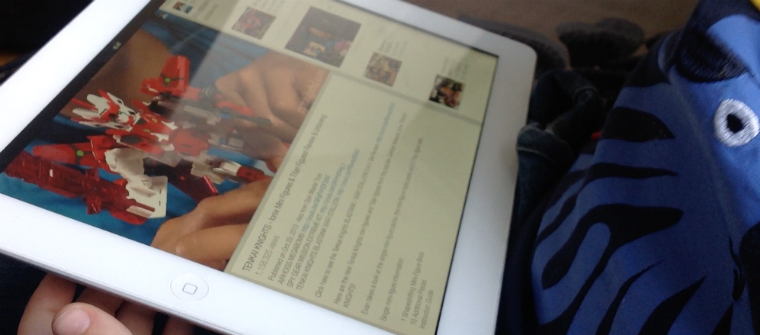Unwrapping the unboxing craze
August 4, 2015
PROJECTS: Preparing for a Digital Future
TAGS: digital media, unboxing, YouTube
What is this new phenomenon of ‘unboxing’? How can we explain its increasing popularity? Guest blogger Jackie Marsh explores the attraction of ‘unboxing’ videos on social media, in an attempt to understand more fully contemporary childhoods. Jackie is Professor of Education in the School of Education at the University of Sheffield, UK. She is interested in the relationship between childhood cultures, play and literacy in the digital age.
For some, ‘unboxing’ was an unfamiliar phenomenon until the word became accepted into the Oxford Dictionaries (OD) – always an indication that something has moved from the margins of cultural practice to being an everyday, accepted activity. Thus, according to the OD, unboxing is, ‘An act or instance of removing a newly purchased product from its packaging and examining its features, typically when filmed and shared on a social media site’.
Online and offline play
I first stumbled across the phenomenon when I was invited to conduct a case study of a child for an international comparative study, led by Professor Anne Haas Dyson in the US, on ‘Child cultures, schooling, and literacy’. The child was to be in her/his first year of schooling, and the aim was to explore the interplay of childhoods, schooling and literacies in case studies conducted across six continents. The child I studied was four-year-old Gareth,1 and, like many children in the UK in contemporary society, Gareth’s cultural, play and literacy practices were firmly embedded in the digital world. Much of the linked online/offline play I observed was very familiar, as Gareth created Lego® artefacts with his plastic bricks and then played with Lego apps on the family tablet. Play increasingly moves across this online and offline interface. One aspect of this was Gareth’s passion for watching YouTube videos featuring children unwrapping Lego products.
Unboxing videos
As the OD definition notes, unboxing videos are shared on social media. YouTube has dozens of channels developed by those who are now ‘unboxing celebrities’ because of the popularity of their YouTube clips. Gareth was a particular fan of one of these celebrities, a child named Evan, whose channel is titled EvanTubeHD.
Gareth is not alone in his appetite for watching unboxing videos. After further investigation, I found that they are viewed by millions of young children (and adults) across the world. One of the most popular adult producers of unboxing video clips, FunToyzCollector, enjoys billions of views of her films, which feature the unboxing of surprise eggs. It is estimated that she receives between US$2 million to US$13 million a year in advertising revenue alone.

Credit: Jackie Marsh
So what’s the attraction?
At first glance, it may seem to some that that the main attraction of these videos is that they offer a form of vicarious consumption, providing evidence that contemporary children are overly-focused on consumer goods. However, we need to consider a range of explanations for this phenomenon, explanations that move beyond an emphasis on the market. In a forthcoming paper,2 I propose the following possible reasons for this recent craze:
- The videos feature toys and artefacts that are of great interest to children. They may even own some of the goods themselves. Therefore, unboxing may be another example of the ‘interest-driven’ use of the internet, identified by Mimi Ito and colleagues. The videos reflect something of the children’s own lives and passions, and they can participate in affinity-based group activities.
- Some of the videos feature child presenters – there is an increasing appetite from young children for peer-produced online content, or content that appears to be child-led.
- Children get pleasure from watching others open presents, but this doesn’t mean they necessarily want to own the item themselves. Gareth’s mum, for example, told me that he did not ask for the products endorsed by EvanHD. This could be an instance of the child as cyberflâneur, enjoying the viewing, but not necessarily wanting to make the purchase. (Flâneur is a term developed in 19th-century Paris, with the advent of its shopping arcades, to describe an individual who enjoys strolling the streets, window-shopping. ‘Cyberflâneur’ translates this practice to the internet.)
- There is a mystery to some of the unboxing videos, and children love surprises. I remember when I was a young child in the early sixties, I saved pocket money to buy ‘lucky bags’, which always contained a cheap plastic toy that was of little monetary value, but the surprise element was key to its appeal. Unboxing videos, it seems to me, offers a 21st-century version of ‘lucky bags’.
- There may be aesthetic and emotional pulls towards this kind of material – the crinkle of paper as it is pulled away from the item, the focus on hands as they unwrap a product, the sound of the toy being played with once freed from its wrapper. These may conjure up memories for children of unwrapping presents themselves, bringing back positive memories.
This is all speculation, of course. I suspect that the appeal of these unboxing videos will be particular in nature to each case, relating to children’s individual interests and specific contexts. Nevertheless, whatever the reasons for their popularity, it is clear that unboxing videos are not going to lose their appeal anytime soon, and so it is incumbent on us to try to understand what is going on, and to consider how the practice relates to young viewers’ everyday lives in order to develop a fuller understanding of contemporary childhoods.

